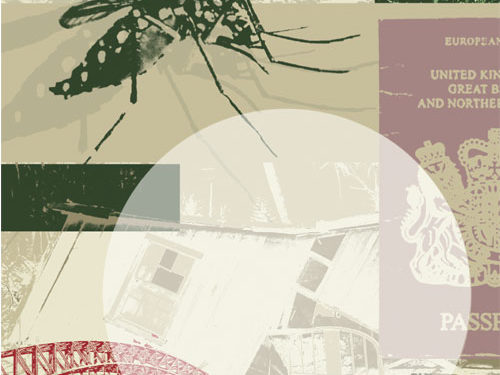Designer Spotlight: Clare Nicholas

Clare Nicholas graduated in 1986 from Bristol Polytechnic, U.K., with a B.A. (HON) 1st Class in Fine Art, Specializing in Printmaking. She continued her studies in printmaking at the Royal College of Art in London, but was soon lured in by the illustration department next door. In 1988, she sold a number of pieces at her graduation, including a piece to the Art Director of British Vogue. She was later commissioned by the same publication to produce an illustration for a horoscope feature.
Clare has used her printmaking skills in conjunction with Photoshop and Illustrator to create fantastic, unique pieces of art that retain the feel of handcrafted images. Her work has attracted myriad clients, including BBC Worldwide, The Ecologist, Southampton University, and Reed Business Information. Currently, she’s producing an ongoing series of images for the BBC magazine, Who Do You Think You Are?, which supports a TV show exploring our ancestry.
Layers: How have you incorporated your training in traditional printmaking with the digital world of Photoshop and Illustrator?
Nicholas: Printmaking is a wonderful medium that boasts many different processes, each with their own unique characteristics. It’s an indirect method of mark making that involves creating a plate or block or screen to produce the picture. Each process requires sensitivity to its limits. I always enjoyed combining printmaking methods, such as lithography and etching, to capitalize on each technique. Images can be constructed by layering and overlapping, sometimes transparent marks and areas of form. This compares quite closely to the way I work using Photoshop and Illustrator combined: I collect reference material in the form of photographs, simplifying the images by heightening the contrast and sometimes creating silhouettes. Then I apply texture and marks to them, which I’ve manufactured by freehand and scanned. I create my textures and marks using rollers, brushes, and paint spray, sometimes working into the textures when dry by scraping and scratching back to the negative.
I was always interested in pushing the boundaries of the medium by breaking the rules a little and found hand burnishing and over-inking relief prints gave them unique and interesting qualities. In this way the process had its own unpredictable input into the creation of a piece.
One of the things that I like about using Photoshop is the interaction between the software and myself. I see it not just as a tool but almost as having its own personality, which often contributes unexpectedly to my image making. Being self-taught means that quite often mistakes provide an inspired approach to composing that I’d never have arrived at logically. I see myself very much as a Photoshop novice exploring the possibilities, having fun, and adapting my style as I learn.

Layers: How much input do your clients have in the initial concept for your designs?
Nicholas: The level of input from clients varies a lot but I generally prefer to have the freedom to come up with my own concept, as I find that too much art direction can sometimes suffocate the creative process for me.
Layers: What’s the key to unifying your digital montages into a single message?
Nicholas: I like to use a limited color palette and to keep the dynamic simple by making the images fairly minimal and unified by the textures and fluidity of the marks. By using a limited color palette, the visual journey can be controlled and softened.
Layers: Your work has been used in industries ranging from business to food to medicine. What is it about your particular style that makes it so versatile for such a wide range of subjects?
Nicholas: I think my printmaking knowledge has led to a technique with a very organic friendly feel. In this way it’s particularly successful when applied to natural subjects. I do have regular input to a British publication called Estates Gazette, which often features my illustrations in the legal section. Although it can be a rather starchy topic, my approach seems to provide a sympathetic visual solution.

Layers: Where do you find inspiration for your particular style of art?
Nicholas: I love the simplicity and color of the 1950’s designs and I particularly like the work of Alvin Lustig. I draw inspiration from a wide base of influences. Three contemporary illustrators whose work I admire are Kate Miller, Sara Fanelli, and Roman Klonek.
Layers: If deadlines weren’t an issue, would you prefer to spend more time printmaking or working in Photoshop?
Nicholas: I guess I do miss the printing process but my move toward digital production was induced by a need for speed. When it comes to commissioned work, I find that digital is much preferable, as it’s infinitely easier to edit.
I think there’s also less inclination to become possessive about the piece. When you craft an image by hand, it really is a labor of love, and having an outside input can be difficult to embrace. There’s also, of course, the added benefit of remaining clean!
Contact Clare Nicholas http://altpick.com/clarenicholas
ALL IMAGES BY CLARE NICHOLAS


